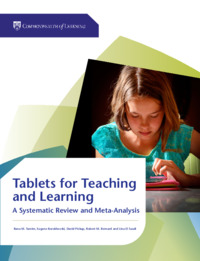Tablets for Teaching and LearningA Systematic Review and Meta-Analysis
|

|
 Diese Seite wurde seit 7 Jahren inhaltlich nicht mehr aktualisiert.
Unter Umständen ist sie nicht mehr aktuell.
Diese Seite wurde seit 7 Jahren inhaltlich nicht mehr aktualisiert.
Unter Umständen ist sie nicht mehr aktuell.
 Zusammenfassungen
Zusammenfassungen
 Similar to results from previous meta-analyses addressing the impact of technology
integration on students’ performance, findings from the current meta-analysis indicate a
moderate strength average effect size for the impact of tablets and smart mobile devices
on student outcome measures. Although not statistically tested, the current findings also
indicate that higher effect sizes result when the devices are used in a student-centred context
and approach rather than within teacher-led environments.
Similar to results from previous meta-analyses addressing the impact of technology
integration on students’ performance, findings from the current meta-analysis indicate a
moderate strength average effect size for the impact of tablets and smart mobile devices
on student outcome measures. Although not statistically tested, the current findings also
indicate that higher effect sizes result when the devices are used in a student-centred context
and approach rather than within teacher-led environments. Tablets and smart mobile devices are the most recent addition to the long list of
technological innovations believed to support and enhance the teaching process and learning
process. This review aimed at going beyond the general hype around tablets and smart
mobile devices to investigate the evidence supporting their use in educational contexts. To
achieve this purpose, a systematic review of quantitative and qualitative research studies
published since 2010 was completed. A rigorous review process resulted in the inclusion
of 27 quantitative studies that were subjected to a full-scale meta-analytic procedure, and
41 qualitative research studies that were reviewed for substantive study characteristics. A
significant average effect size was found for studies comparing tablet use contexts with no
tablet use contexts (g+ = 0.23, k = 28). For studies comparing two different uses of tablets
by students, the average effect size (g+ = 0.68, k = 12) showed a significant favouring of
more student-centred pedagogical use of technology. Although not statistically tested, the
findings also indicate that higher effect sizes are achieved when the devices are used with
a student-centred approach rather than within teacher-led environments. Similarly, the
qualitative literature review revealed that tablets and smart mobile devices are garnering
positive perceptions within educational contexts, with the strongest support showing for
the technologies’ effectiveness in particular tasks and when used within more student-active
contexts. Finally, the review provides an overview of the Turkish Fatih Project as a case study
and highlights the lessons learned.
Tablets and smart mobile devices are the most recent addition to the long list of
technological innovations believed to support and enhance the teaching process and learning
process. This review aimed at going beyond the general hype around tablets and smart
mobile devices to investigate the evidence supporting their use in educational contexts. To
achieve this purpose, a systematic review of quantitative and qualitative research studies
published since 2010 was completed. A rigorous review process resulted in the inclusion
of 27 quantitative studies that were subjected to a full-scale meta-analytic procedure, and
41 qualitative research studies that were reviewed for substantive study characteristics. A
significant average effect size was found for studies comparing tablet use contexts with no
tablet use contexts (g+ = 0.23, k = 28). For studies comparing two different uses of tablets
by students, the average effect size (g+ = 0.68, k = 12) showed a significant favouring of
more student-centred pedagogical use of technology. Although not statistically tested, the
findings also indicate that higher effect sizes are achieved when the devices are used with
a student-centred approach rather than within teacher-led environments. Similarly, the
qualitative literature review revealed that tablets and smart mobile devices are garnering
positive perceptions within educational contexts, with the strongest support showing for
the technologies’ effectiveness in particular tasks and when used within more student-active
contexts. Finally, the review provides an overview of the Turkish Fatih Project as a case study
and highlights the lessons learned. Dieses Buch erwähnt ...
Dieses Buch erwähnt ...
 Personen KB IB clear | Richard E. Clark , Gene V. Glass , Barry McGaw , Mary Lee Smith | |||||||||||||||||||||||||||
 Fragen KB IB clear | Was bringen Handhelds/PDAs in der Schule? | |||||||||||||||||||||||||||
 Begriffe KB IB clear | Bildungeducation (Bildung)
, Effektstärkeeffect size
,  Innovation Innovation innovation
, innovation
,  LehrerIn LehrerIn teacher
, teacher
,  Lernen Lernen learning
, Metaanalysemeta-analysis
, learning
, Metaanalysemeta-analysis
,  Schule Schule school
, school
,  Tablet Tablet Tablet
, Tablets in educationTablets in education
, Tablet
, Tablets in educationTablets in education
,  Unterricht Unterricht
| |||||||||||||||||||||||||||
 Bücher |
| |||||||||||||||||||||||||||
 Texte |
|
 Dieses Buch erwähnt vermutlich nicht ...
Dieses Buch erwähnt vermutlich nicht ... 
 Nicht erwähnte Begriffe | Digitalisierung, Eltern, iPad, Kinder, Primarschule (1-6) / Grundschule (1-4), Schweiz |
 Tagcloud
Tagcloud
 Zitationsgraph
Zitationsgraph
 Zitationsgraph (Beta-Test mit vis.js)
Zitationsgraph (Beta-Test mit vis.js)
 1 Erwähnungen
1 Erwähnungen 
- Medien und Schule - Unterrichten mit Whiteboard, Smartphone und Co. (Heike Schaumburg, Doreen Prasse) (2018)


 Volltext dieses Dokuments
Volltext dieses Dokuments
 |  Tablets for Teaching and Learning: Gesamtes Buch als Volltext ( Tablets for Teaching and Learning: Gesamtes Buch als Volltext ( : :  , 926 kByte; , 926 kByte;  : :  2021-03-21) 2021-03-21) |
 Anderswo suchen
Anderswo suchen 
 Beat und dieses Buch
Beat und dieses Buch
Beat hat dieses Buch während seiner Zeit am Institut für Medien und Schule (IMS) ins Biblionetz aufgenommen. Beat besitzt kein physisches, aber ein digitales Exemplar. Eine digitale Version ist auf dem Internet verfügbar (s.o.). Es gibt bisher nur wenige Objekte im Biblionetz, die dieses Werk zitieren.









 Biblionetz-History
Biblionetz-History